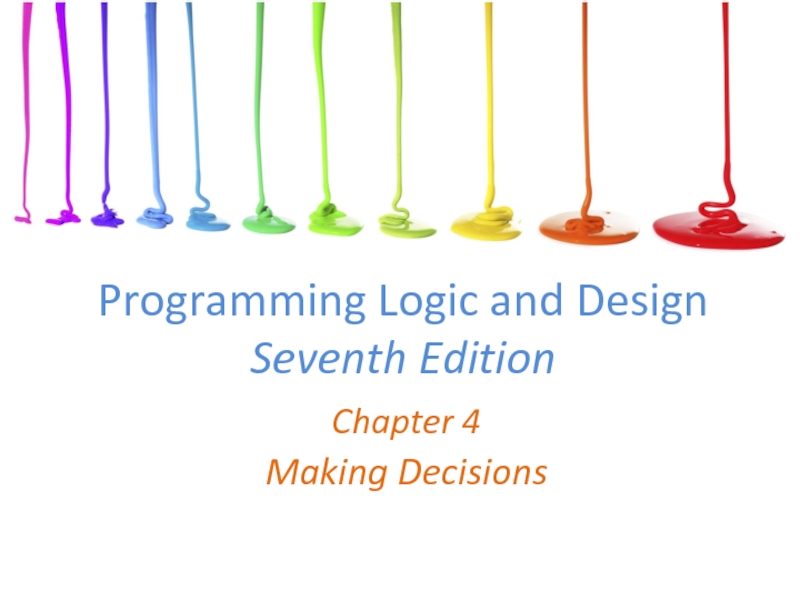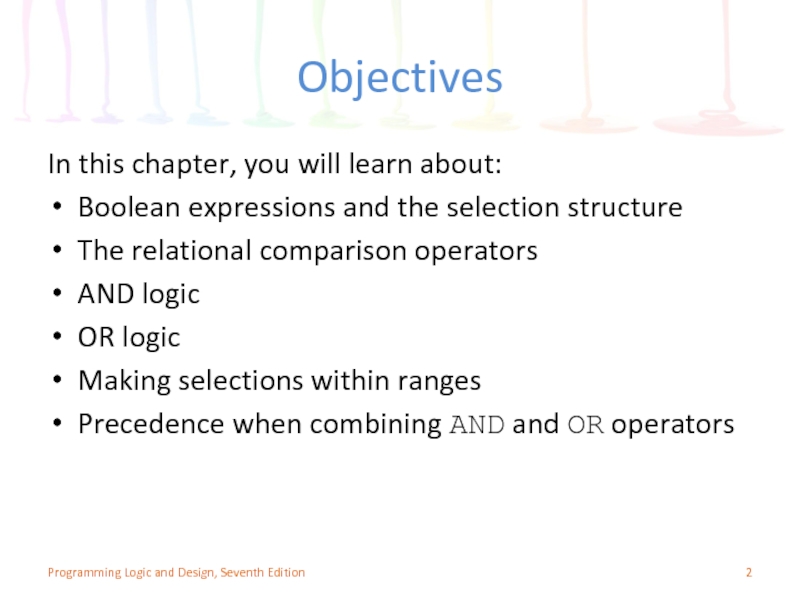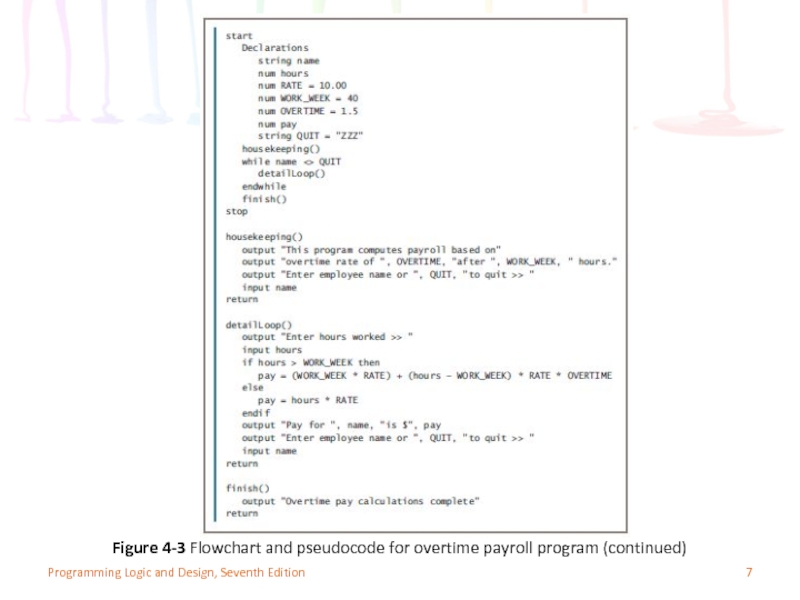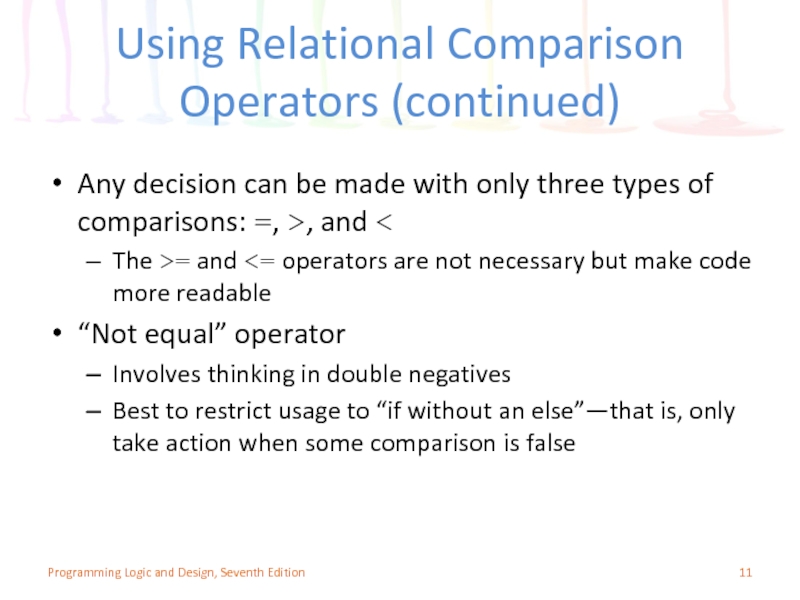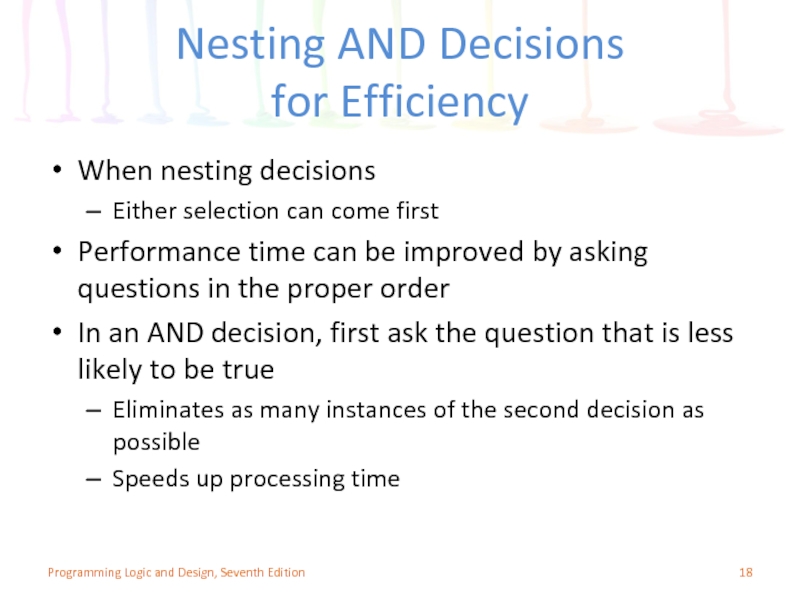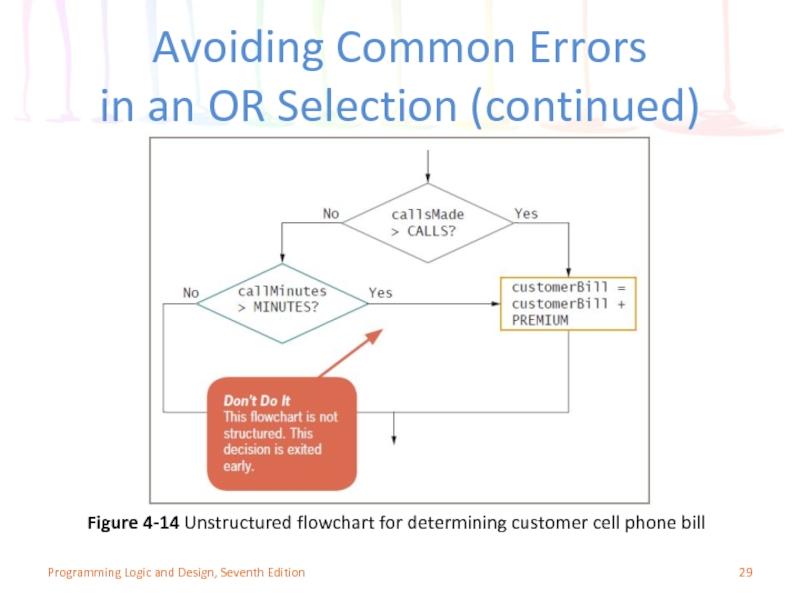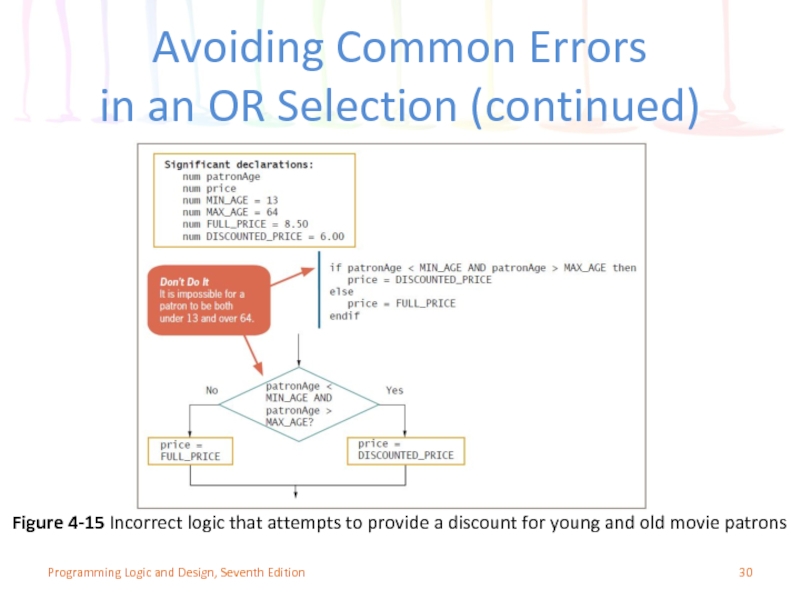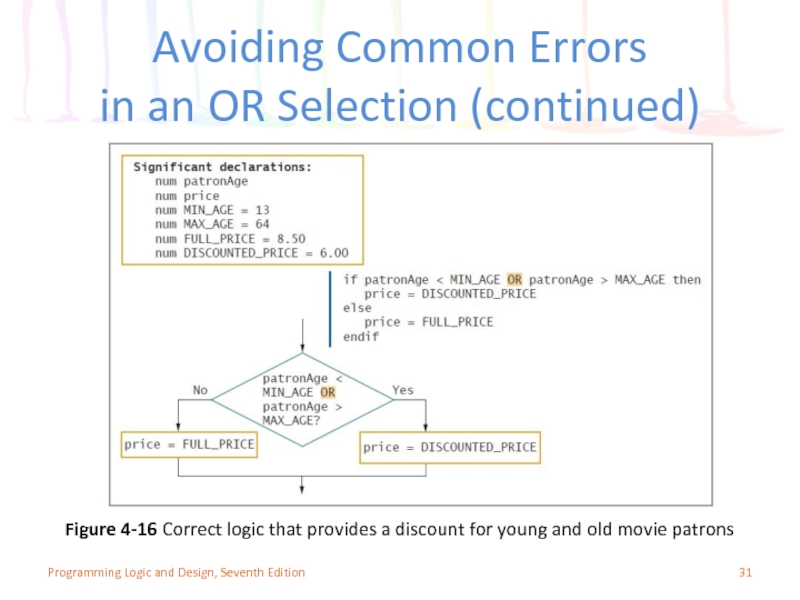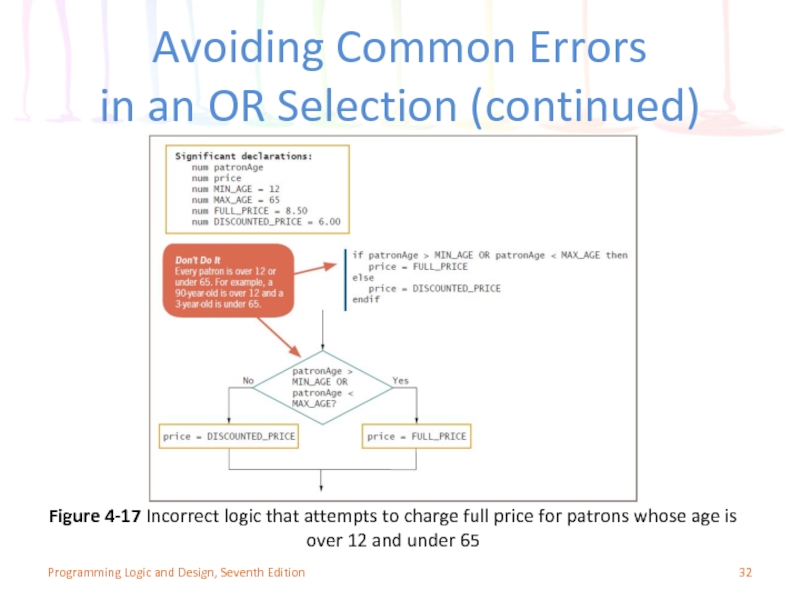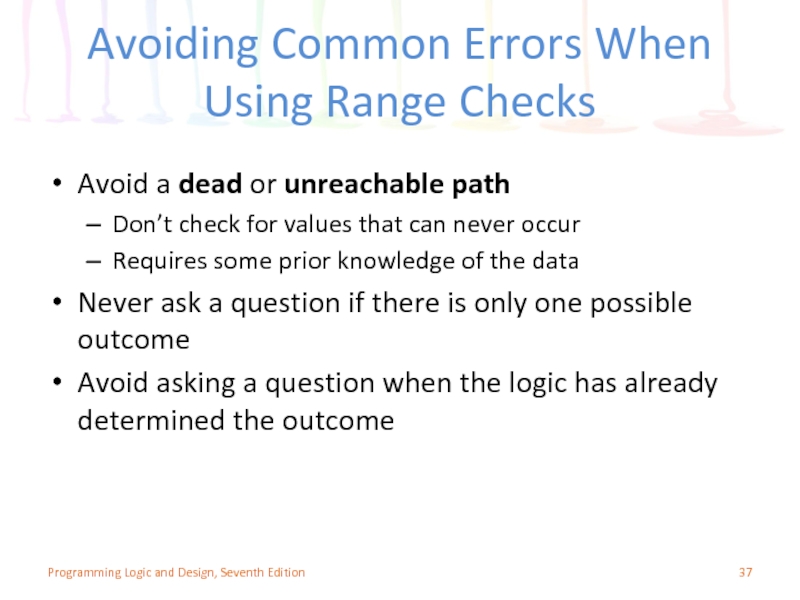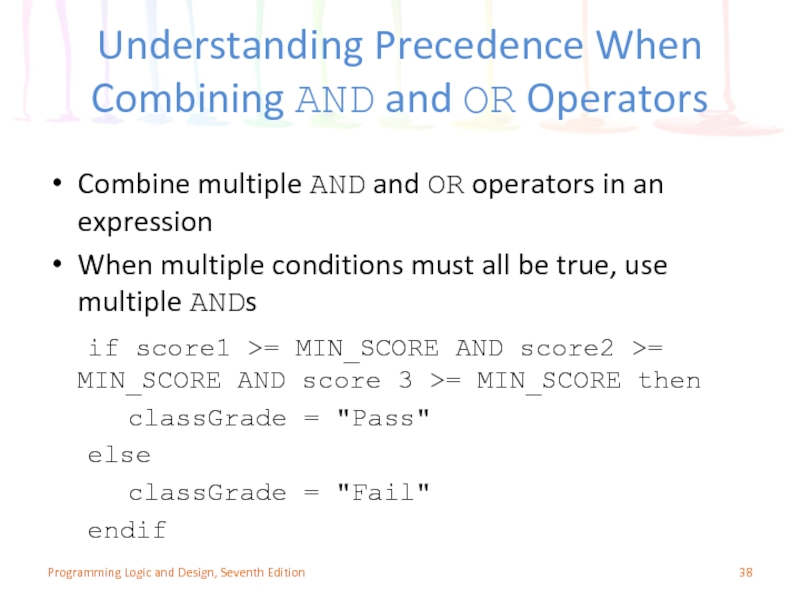- Главная
- Разное
- Дизайн
- Бизнес и предпринимательство
- Аналитика
- Образование
- Развлечения
- Красота и здоровье
- Финансы
- Государство
- Путешествия
- Спорт
- Недвижимость
- Армия
- Графика
- Культурология
- Еда и кулинария
- Лингвистика
- Английский язык
- Астрономия
- Алгебра
- Биология
- География
- Детские презентации
- Информатика
- История
- Литература
- Маркетинг
- Математика
- Медицина
- Менеджмент
- Музыка
- МХК
- Немецкий язык
- ОБЖ
- Обществознание
- Окружающий мир
- Педагогика
- Русский язык
- Технология
- Физика
- Философия
- Химия
- Шаблоны, картинки для презентаций
- Экология
- Экономика
- Юриспруденция
Programming Logic and Design Seventh Edition. Chapter 4. Making Decisions презентация
Содержание
- 1. Programming Logic and Design Seventh Edition. Chapter 4. Making Decisions
- 2. Objectives In this chapter, you will learn
- 3. Boolean Expressions and the Selection Structure Boolean
- 4. Boolean Expressions and the Selection Structure (continued)
- 5. Boolean Expressions and the Selection Structure (continued)
- 6. Programming Logic and Design, Seventh Edition Figure 4-3 Flowchart and pseudocode for overtime payroll program
- 7. Programming Logic and Design, Seventh Edition Figure
- 8. Boolean Expressions and the Selection Structure (continued)
- 9. Using Relational Comparison Operators Relational
- 10. Programming Logic and Design, Seventh Edition Table 4-1 Relational comparison operators
- 11. Using Relational Comparison Operators (continued) Any decision
- 12. Using Relational Comparison Operators (continued) Programming Logic
- 13. Using Relational Comparison Operators (continued) Programming Logic
- 14. Avoiding a Common Error with Relational Operators
- 15. Understanding AND Logic Compound condition Asks multiple
- 16. Programming Logic and Design, Seventh Edition Figure
- 17. Programming Logic and Design, Seventh Edition Figure
- 18. Nesting AND Decisions for Efficiency When
- 19. Using the AND Operator Conditional AND operator
- 20. Using the AND Operator (continued) Programming Logic
- 21. Programming Logic and Design, Seventh Edition Figure
- 22. Avoiding Common Errors in an AND
- 23. Understanding OR Logic OR decision Take action
- 24. Writing OR Decisions for Efficiency May ask
- 25. Using the OR Operator Conditional OR operator
- 26. Using the OR Operator (continued) Programming
- 27. Programming Logic and Design, Seventh Edition Figure
- 28. Avoiding Common Errors in an OR
- 29. Avoiding Common Errors in an OR
- 30. Avoiding Common Errors in an OR
- 31. Avoiding Common Errors in an OR
- 32. Avoiding Common Errors in an OR
- 33. Avoiding Common Errors in an OR
- 34. Making Selections within Ranges Range check Compare
- 35. Making Selections within Ranges (continued) Programming Logic
- 36. Programming Logic and Design, Seventh Edition Figure
- 37. Avoiding Common Errors When Using Range Checks
- 38. Understanding Precedence When Combining AND and OR
- 39. Understanding Precedence When Combining AND and OR
- 40. When AND and OR operators are combined
- 41. Mixing AND and OR operators makes logic
- 42. Programming Logic and Design, Seventh Edition Figure 4-23 Nested decisions that determine movie patron discount
- 43. Summary Decisions involve evaluating Boolean expressions Use
- 44. Summary (continued) In an OR decision, first
Слайд 2Objectives
In this chapter, you will learn about:
Boolean expressions and the selection
The relational comparison operators
AND logic
OR logic
Making selections within ranges
Precedence when combining AND and OR operators
Programming Logic and Design, Seventh Edition
Слайд 3Boolean Expressions
and the Selection Structure
Boolean expressions can be only true or
Every computer decision yields a true-or-false, yes-or-no, 1-or-0 result
Used in every selection structure
Programming Logic and Design, Seventh Edition
Слайд 4Boolean Expressions and the Selection Structure (continued)
Dual-alternative (or binary) selection structure
Provides
Programming Logic and Design, Seventh Edition
Figure 4-1 The dual-alternative selection structure
Слайд 5Boolean Expressions and the Selection Structure (continued)
Single-alternative (or unary) selection structure
Action
if-then
Programming Logic and Design, Seventh Edition
Figure 4-2 The single-alternative selection structure
Слайд 6Programming Logic and Design, Seventh Edition
Figure 4-3 Flowchart and pseudocode for
Слайд 7Programming Logic and Design, Seventh Edition
Figure 4-3 Flowchart and pseudocode for
Слайд 8Boolean Expressions and the Selection Structure (continued)
if-then-else decision
if-then clause
Holds the action
else clause
Executes only when the tested condition in the decision is false
Programming Logic and Design, Seventh Edition
Слайд 9Using Relational
Comparison Operators
Relational comparison operators
Six types supported by all
Two values compared can be either variables or constants
Trivial expressions
Will always evaluate to the same result
Examples:
true for 20 = 20?
false for 30 = 40?
Programming Logic and Design, Seventh Edition
Слайд 11Using Relational Comparison Operators (continued)
Any decision can be made with only
The >= and <= operators are not necessary but make code more readable
“Not equal” operator
Involves thinking in double negatives
Best to restrict usage to “if without an else”—that is, only take action when some comparison is false
Programming Logic and Design, Seventh Edition
Слайд 12Using Relational Comparison Operators (continued)
Programming Logic and Design, Seventh Edition
Figure 4-5
Слайд 13Using Relational Comparison Operators (continued)
Programming Logic and Design, Seventh Edition
Figure 4-6
Слайд 14Avoiding a Common Error with
Relational Operators
Common errors
Using the wrong operator
Think
Think small < BIG
Missing the boundary or limit required for a selection
Programming Logic and Design, Seventh Edition
Слайд 15Understanding AND Logic
Compound condition
Asks multiple questions before an outcome is determined
AND
Requires that both of two tests evaluate to true
Requires a nested decision (nested if) or a cascading if statement
Programming Logic and Design, Seventh Edition
Слайд 16Programming Logic and Design, Seventh Edition
Figure 4-7 Flowchart and pseudocode for
Слайд 17Programming Logic and Design, Seventh Edition
Figure 4-7 Flowchart and pseudocode for
Слайд 18Nesting AND Decisions
for Efficiency
When nesting decisions
Either selection can come first
Performance
In an AND decision, first ask the question that is less likely to be true
Eliminates as many instances of the second decision as possible
Speeds up processing time
Programming Logic and Design, Seventh Edition
Слайд 19Using the AND Operator
Conditional AND operator
Ask two or more questions
Each Boolean expression must be true for entire expression to evaluate to true
Truth tables
Describe the truth of an entire expression based on the truth of its parts
Short-circuit evaluation
Expression evaluated only as far as necessary to determine truth
Programming Logic and Design, Seventh Edition
Слайд 20Using the AND Operator (continued)
Programming Logic and Design, Seventh Edition
Table 4-2
Слайд 21Programming Logic and Design, Seventh Edition
Figure 4-9 Using an AND operator
Слайд 22Avoiding Common Errors
in an AND Selection
Second decision must be made
In most programming languages, logical AND is a binary operator
Requires a complete Boolean expression on both sides
Programming Logic and Design, Seventh Edition
Слайд 23Understanding OR Logic
OR decision
Take action when one or the other of
Example
“Are you free for dinner Friday or Saturday?”
Programming Logic and Design, Seventh Edition
Слайд 24Writing OR Decisions for Efficiency
May ask either question first
Both produce the
If first question is true, no need to ask second
In an OR decision, first ask the question that is more likely to be true
Eliminate as many extra decisions as possible
Programming Logic and Design, Seventh Edition
Слайд 25Using the OR Operator
Conditional OR operator
Ask two or more questions
Only one Boolean expression in an OR selection must be true to produce a result of true
Question placed first will be asked first
Consider efficiency
Computer can ask only one question at a time
Programming Logic and Design, Seventh Edition
Слайд 26Using the OR Operator
(continued)
Programming Logic and Design, Seventh Edition
Table 4-3
Слайд 27Programming Logic and Design, Seventh Edition
Figure 4-13 Using an OR operator
Слайд 28Avoiding Common Errors
in an OR Selection
Second question must be a
Request for A and B in English logically means a request for A or B
Example
“Add $20 to the bill of anyone who makes more than 100 calls and to anyone who has used more than 500 minutes”
“Add $20 to the bill of anyone who has made more than 100 calls or has used more than 500 minutes”
Programming Logic and Design, Seventh Edition
Слайд 29Avoiding Common Errors
in an OR Selection (continued)
Programming Logic and Design,
Figure 4-14 Unstructured flowchart for determining customer cell phone bill
Слайд 30Avoiding Common Errors
in an OR Selection (continued)
Programming Logic and Design,
Figure 4-15 Incorrect logic that attempts to provide a discount for young and old movie patrons
Слайд 31Avoiding Common Errors
in an OR Selection (continued)
Programming Logic and Design,
Figure 4-16 Correct logic that provides a discount for young and old movie patrons
Слайд 32Avoiding Common Errors
in an OR Selection (continued)
Programming Logic and Design,
Figure 4-17 Incorrect logic that attempts to charge full price for patrons whose age is over 12 and under 65
Слайд 33Avoiding Common Errors
in an OR Selection (continued)
Programming Logic and Design,
Figure 4-18 Correct logic that charges full price for patrons whose age is over 12 and under 65
Слайд 34Making Selections within Ranges
Range check
Compare a variable to a series of
Use the lowest or highest value in each range
Adjust the question logic when using highest versus lowest values
Should end points of the range be included?
Yes: use >= or <=
No: use < or >
Programming Logic and Design, Seventh Edition
Слайд 35Making Selections within Ranges (continued)
Programming Logic and Design, Seventh Edition
Figure 4-19
Слайд 36Programming Logic and Design, Seventh Edition
Figure 4-20 Flowchart and pseudocode of
Слайд 37Avoiding Common Errors When Using Range Checks
Avoid a dead or unreachable
Don’t check for values that can never occur
Requires some prior knowledge of the data
Never ask a question if there is only one possible outcome
Avoid asking a question when the logic has already determined the outcome
Programming Logic and Design, Seventh Edition
Слайд 38Understanding Precedence When Combining AND and OR Operators
Combine multiple AND and
When multiple conditions must all be true, use multiple ANDs
if score1 >= MIN_SCORE AND score2 >= MIN_SCORE AND score 3 >= MIN_SCORE then
classGrade = "Pass"
else
classGrade = "Fail"
endif
Programming Logic and Design, Seventh Edition
Слайд 39Understanding Precedence When Combining AND and OR Operators (cont’d)
When only one
if score1 >= MIN_SCORE OR score2 >= MIN_SCORE OR score3 >= MIN_SCORE then
classGrade = "Pass"
else
classGrade = "Fail"
endif
Programming Logic and Design, Seventh Edition
Слайд 40When AND and OR operators are combined in the same statement,
if age <= 12 OR age >= 65 AND rating = "G"
Use parentheses to correct logic and force evaluations to occur in the order desired
if (age <= 12 OR age >= 65) AND rating = "G"
Programming Logic and Design, Seventh Edition
Understanding Precedence When Combining AND and OR Operators (cont’d)
Слайд 41Mixing AND and OR operators makes logic more complicated
Can avoid mixing
Programming Logic and Design, Seventh Edition
Understanding Precedence When Combining AND and OR Operators (cont’d)
Слайд 42Programming Logic and Design, Seventh Edition
Figure 4-23 Nested decisions that determine
Слайд 43Summary
Decisions involve evaluating Boolean expressions
Use relational operators to compare values
An AND
In an AND decision, first ask the question that is less likely to be true
An OR decision requires that either of the conditions be true to produce a true result
Programming Logic and Design, Seventh Edition
Слайд 44Summary (continued)
In an OR decision, first ask the question that is
For a range check:
Make comparisons with the highest or lowest values in each range
Eliminate unnecessary or previously answered questions
The AND operator takes precedence over the OR operator
Programming Logic and Design, Seventh Edition
